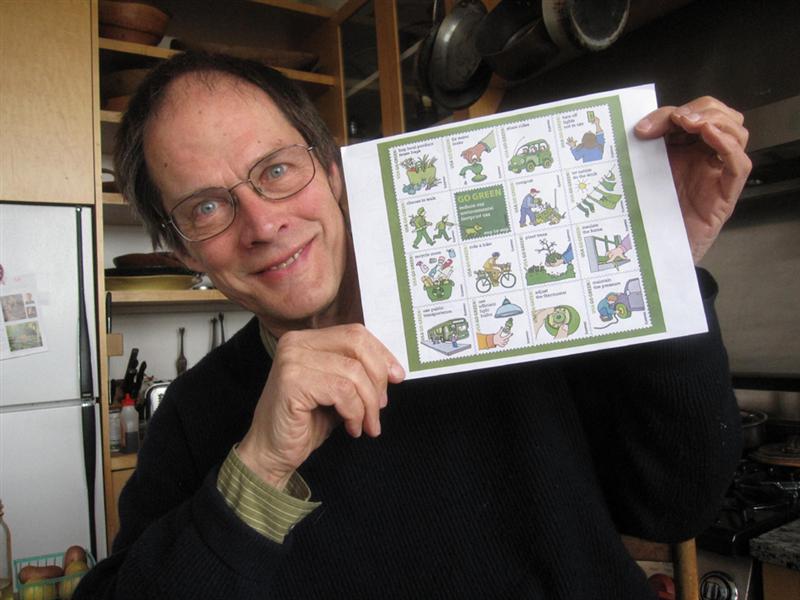
RETURN TO HOME PAGE
FEEDBACK
 |
May 2011 RETURN TO HOME PAGE FEEDBACK |
By Heather World

Eli Noyes drew on his experience in film animation to create his eco-friendly stamps. Photo by Pamela Gerard
New postage stamps may have more people walking to the post office, thanks to Eli Noyes, a Noe Valley artist who designed a sheet of stamps depicting simple ways to scale back one’s environmental footprint.The U.S. Postal Service released his 16 designs on Earth Day, along with a host of adjunct products like a family activity kit, plant-able postcards embedded with seeds, and a tote bag. Each stamp suggests an easy way to conserve energy: walk more, recycle more, ride a bike, or plant trees.
“Whether little old me rides a bicycle or drives my car doesn’t make a difference, but collectively it does,” says the 68-year-old Church Street resident. More people using compact florescent lightbulbs means fewer power plants, he says.
“I like the idea of trickle up—individual actions trickle up to the people who they elect, the people running big corporations,” he says.
The theme is not new to Noyes, who has lived in Noe Valley for 15 years. He is a partner in Alligator Planet, LLC, an animation and production company that creates everything from one-minute television commercials to 75-minute animated feature films. Noyes and his partner Ralph Guggenheim have been around for a while and can now afford to take on projects they care about, he says. The company has worked on a number of environmental films and websites, many times for free.
Noyes has a long resume of animation and graphics creation, from a short film on wild animals of the Serengeti shot in his Peace Corps days to stints at Sesame Street and on Nickelodeon children’s TV. The stamps are an extension of that style of educational design, he says.
“I use the skills I learned by making a living in the business, for purposes and causes that really matter,” says Noyes, who was nominated for an Academy Award for his 1965 animated film Clay, or the Origin of Species.
He also follows the tips in his stamps, by walking, biking, and composting. He and his wife recently installed solar panels on their roof. Indeed, Noyes and his wife of 30 years moved from the East Coast to San Francisco when their son and daughter were young, lured by the sensibility that makes the city a leader in recycling and energy efficiency.
Noyes’ stamps will be complemented by an online game, designed by someone else but using his images. Not all stamps come out with such fanfare, says James Wigdel, a spokesman for the San Francisco Postal District.
“It’s all stamp-dependent,” Wigdel says. “These particular stamps have a great message, and it’s a good idea to carry that message through.”
There are about 100 new stamp designs each year, Wigdel points out. Inspiration comes from the 50,000-odd suggestions sent to the Post Office each year, he says. A Citizens’ Stamp Advisory Board chooses stamp themes, then commissions artists to create the designs.
As it happens, Noyes’ sister is a member of that board. Unbeknownst to him, she suggested her environmentally conscious and creative brother illustrate the Earth Day stamp.
“It sounds like nepotism, but it’s not,” Noyes says. “I had to pass muster.”
Typically, Noyes starts his creations on a pad of paper or on an electronic tablet before switching to Photoshop and Illustrator software to develop his ideas. Sometimes he looks up images online for a two-dimensional reference: What does a thermostat really look like? Where is the brand name placed?
“Because I come out of the world of wacky children’s drawings, I wanted a balance,” he says. “I wanted to make [the stamps] look accessible, fun, and informal, yet carefully drawn at the same time.”
Trial and error, as well as feedback from committees within the committee, familiarized him with the particulars of making a stamp: The sheet of designs should have an overall pleasing aesthetic, images must be fairly simple and bold but fill the space, and the end result must look good as a postage stamp as well as a poster.
“I tried one drawing with a car, someone on a bicycle, and someone running,” he says. “I shrunk it and you couldn’t see a thing.”
Green was a natural color choice for the subject, so Noyes bounced different ideas off his sister: green background, green ribbon running through all the stamps.
“We discovered soon that if you made everything green you kind of got sick,” he says. He decided to limit green to one focal point in each stamp, add other colors, and use a white background.
In the end, Noyes had so many ideas for the stamps that he presented 16 designs instead of the usual one to five.
“If you’re trying to appeal to people to really do things to make a difference, you’ve got to say there are a lot of things you could do,” he says.
The commission liked what it saw and created the additional material around the stamp’s release. Noyes’ series, available until the stamps run out, are being sold as “forever stamps,” which will always cover the price of a first-class letter, even if the price rises. The cost for a sheet of 16 is $7.04.
“When it comes to the political and environmental movement, all I know how to do is cajole, gently educate, and entertain,” Noyes says. “For me, the stamps were a perfect opportunity to practice that.”